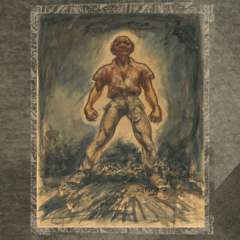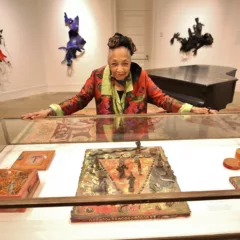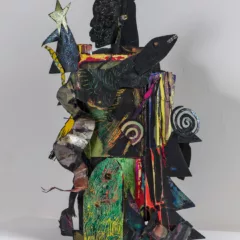“Gardens of the Mind: Echos of the feminine view” at the African American Museum of Philadelphia through January 16, 2018 should appeal to a broad range of visitors. The exhibition, curated by A. M. Weaver, brings together five artists whose work ranges from watercolors, paintings, prints and photography to reliefs, sculpture and video. The association of woman with nature reaches back to prehistory, as numerous, early fertility figures attest. Some feminists such as Nancy Spero have celebrated female deities, while others consider the metaphor of woman = nature as grounded in patriarchy and limiting to the scope of women’s lives. “Gardens of the Mind” offers a range of responses to the topic, more poetic than ideological.
The artist who most clearly addresses the feminine point of view does so in frustration and anger. Joiri Minaya’s tart, 10-minute, narrative video “Siboney” begins with a taunt directed at the viewer: “Do you want a jungle; I’ll give you a jungle.” She then begins, slowly and meticulously, to paint a huge wall with a detailed, repeat pattern of tropical foliage – only to destroy it by wiping her body against the still-wet paint. Her act of creation/destruction is a claim of agency – only she can decide whether to situate herself in or out of the jungle. The choice will certainly be outside the jungle, since her other works, such as the large installation, “#dominicanwomangooglesearch,” reject the narrow and primitivizing stereotypes of Caribbean women she has seen so much of.
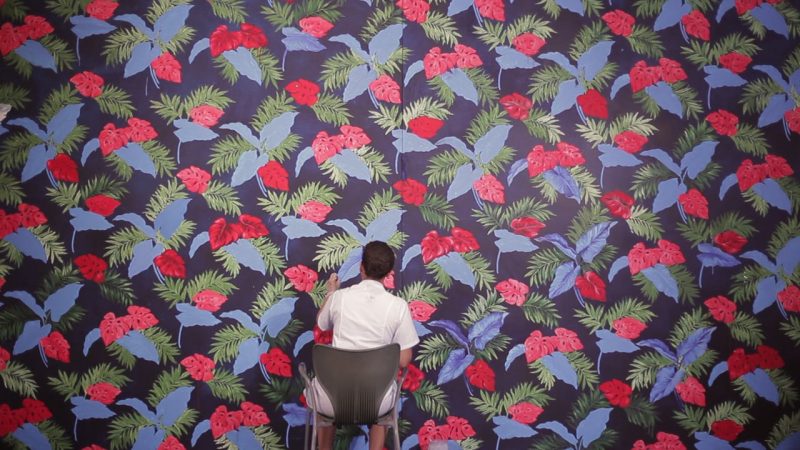
Approaching Martha Jackson Jarvis’s work, I imagined myself entering an unknown, lush landscape whose scale is many times our own. Two huge and extraordinary sculptures are on the floor; one suggests the natural — a twisting branch of giant seed pods, the other is clearly crafted — a branch, both ends of which are encrusted with river-polished jade stones intertwined with bright orange snakeskin. It might be a ceremonial scepter, although Jarvis has titled the two pieces “Umbilicus I and II.” Seven works hang on the walls behind them; all but one are spools of what appears to be richly-patterned parchment, unrolling from upright branches. They read as the metaphorical setting for the floor pieces – possibly texts related to the scepter’s function. Two astonishingly large and richly-painted watercolors of detailed, natural forms also hang on the walls. The openness of interpretation only adds to the power and seduction of Jarvis’ work, which clearly celebrates the fecundity of both nature and culture.
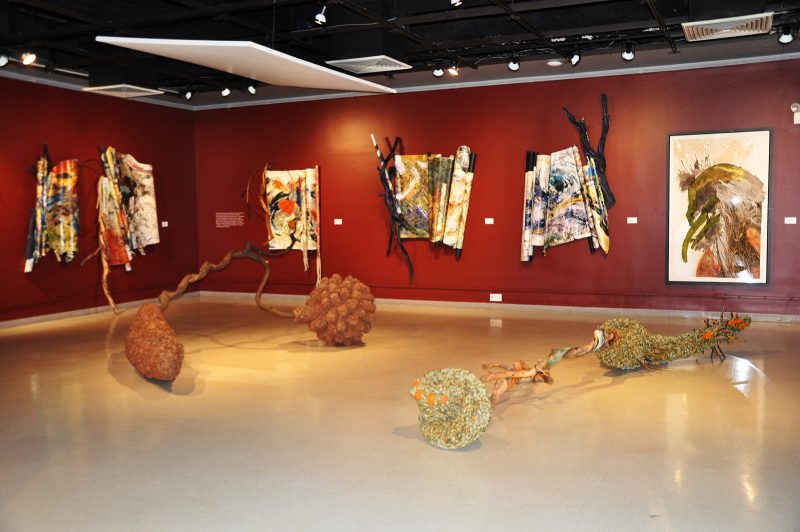
Thirty-two individual reliefs by Barbara Bullock, hung on dark, teal-colored walls, surround viewers in a mysterious environment of ebullient color, pattern and implied motion. The underlying figures of humans, animals and spirits are crafted in black, which adds to the drama of high-keyed colors and texture-encrusted clothing, flowers and other secondary forms. Bullock presents only partial views of a dancer, musician and shaman-figure, as if to suggest bodies moving to music and changing light. Cast shadows interact with hanging, scribbled, ribbon-like extrusions which practically dance off the walls. The artist has created this animated world of animal, human and spirit forms out of the most basic materials: paint on heavy paper which she cuts and fashions into improbably dynamic reliefs – an amazing act of conjuring.
Glynnis Reed’s photographic series, “Nature Abstraction” was shot in a wooded landscape in autumn and makes various uses of its bare tree branches, dried grasses and areas of water. She explores that particular confusion of up and down that can happen when the sky and clouds are reflected in water that we know to be an extension of the ground beneath us. She also intensifies the saturation of the blue where water reflects sky as if to suggest that, as in a double exposure, the camera is summing the blue of both spheres.
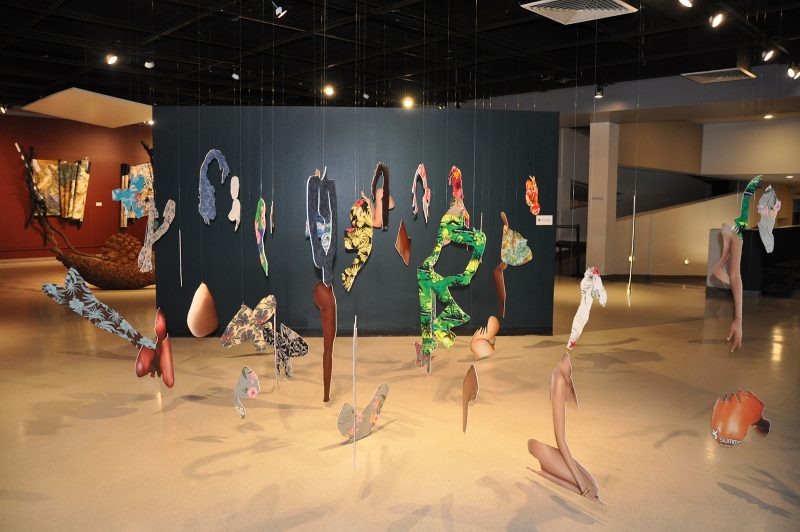
(2016), digital print on sintra and fabric collage.
E. J. Montgomery immerses her viewers in patterned fields of flickering colors, which are most compelling in the two very large panels of semi-sheer cloth she has drawn on and suspended vertically in space, so that viewers can walk around and between them. While the all-over compositions of her many prints and paintings suggest that they are details cropped from much larger fields, the hanging textiles envelop viewers in their own environment. Montgomery’s garden provides a place of relaxation and play conducive to reverie and imagination.
I am not convinced by the curator’s contention that the work in this exhibition reflects “a connectivity to the earth and living matter particular to [the artists’] gaze as women,” since I can imagine paintings by Rafael Ferrer, Keith Morrison, Chris Ofili and Arnaldo Roche Rabell or performance work by Guillermo Gómez-Peña would fit very well with the art assembled here. And I don’t think this matters; the work of these five artists stands on its own. The exhibition offers a rich, visual experience to viewers who can approach it without specialized knowledge of art or feminist discourse.



